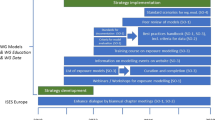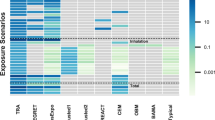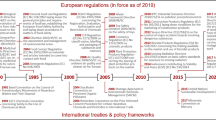Abstract
The new European chemicals legislation REACH (Registration, Evaluation, Authorisation and restriction of Chemicals) requires the development of Exposure Scenarios describing the conditions and risk management measures needed for the safe use of chemicals. Such Exposure Scenarios should integrate considerations of both human health and the environment. Specific aspects are relevant for worker exposure. Gathering information on the uses of the chemical is an important step in developing an Exposure Scenario. In-house information at manufacturers is an important source. Downstream users can contribute information through direct contact or through their associations. Relatively simple approaches (Tier 1 tools, such as the ECETOC Targeted Risk Assessment and the model EASE) can be used to develop broad Exposure Scenarios that cover many use situations. These approaches rely on the categorisation of just a few determinants, including only a small number of risk management measures. Such approaches have a limited discriminatory power and are rather conservative. When the hazard of the substance or the complexity of the exposure situation require a more in-depth approach, further development of the Exposure Scenarios with Tier 2 approaches is needed. Measured data sets of worker exposure are very valuable in a Tier 2 approach. Some downstream user associations have attempted to build Exposure Scenarios based on measured data sets. Generic Tier 2 tools for developing Exposure Scenarios do not exist yet. To enable efficient development of the worker exposure part of Exposure Scenarios a further development of Tier 1 and Tier 2 tools is needed. Special attention should be given to user friendliness and to the validity (boundaries) of the approaches. The development of standard worker exposure descriptions or full Exposure Scenarios by downstream user branches in cooperation with manufacturers and importers is recommended.
This is a preview of subscription content, access via your institution
Access options
Subscribe to this journal
Receive 6 print issues and online access
$259.00 per year
only $43.17 per issue
Buy this article
- Purchase on Springer Link
- Instant access to full article PDF
Prices may be subject to local taxes which are calculated during checkout







Similar content being viewed by others
References
Ahrens A. Exemplification of Exposure Scenario Development and CSA—Overview on 8 (of 14) Cases 2006. Presentation at the Workshop on Exposure Scenarios, Arona, November 7 and 8, 2006 (http://ecb.jrc.it/DOCUMENTS/REACH/ARONA_NETWORK_ON_EXPOSURE_SCENARIOS/3rd_WORKSHOP_ON_7_AND_8_NOV_2006/PRESENTATIONS/Ahrens%20Overview%20of%20cases%20.ppt).
Ahrens A., Jepsen D., Heitmann K., and Claus F. The SPORT Report. Making REACH Work in Practice (Hamburg, 2005) 2005: (http://ecb.jrc.it/DOCUMENTS/REACH/STRATEGIC_PARTNERSHIPS/SPORT_report_050705.pdf).
Bock W., Brock T.J., Stamm R., and Wittneben V. Existing Commercial Chemicals–Exposure at the Workplace 1999, Report 1/99e HVBG, Sankt Augustin. ISBN: 3-88383-573-0.
Brouwer D.H., Semple S., Marquart J., and Cherrie J.W. A dermal model for spray painters. Part I: subjective exposure modelling of spray paint deposition. Ann of Occup Hyg 2001: 45(1): 15–23.
Cherrie J.W., and Schneider T. Validation of a new method for structured subjective assessment of past concentrations. Ann Occup Hyg 1999: 43: 235–245.
Cherrie J.W., Schneider T., Spankie S., and Quinn M. A new method for structured, subjective assessments of past concentrations. Occupational Hygiene 1996: 3(1–3): 75–83.
Creely K.S., Tickner J., Soutar A.J., Hughson G.W., Pryde D.E., Warren N.D., Rae R., Money C., Phillips A., and Cherrie J.W. Evaluation and further development of EASE model 2.0. Ann Occup Hyg 2005: 49(2): 135–145.
EC. Commission of the European Communities. COMMISSION REGULATION (EC) No 1488/94 of 28 June 1994 laying down the principles for the assessment of risks to man and the environment of existing substances in accordance with Council Regulation (EEC) No793/93. OJ 1994: L161: 3–11.
EC. Council of the European Union. COUNCIL DIRECTIVE 98/24/EC of 7 April 1998 on the protection of the health and safety of workers from the risks related to chemical agents at work (fourteenth individual Directive within the meaning of Article 16(1) of Directive 89/391/EEC). OJ 1998: L131: 11–23.
EC. Technical Guidance Document on Risk Assessment in Support of Commission Regulation (EC) No 1488/94 on Risk Assessment for Existing Substances; Commission Directive 93/67/EEC on Risk Assessment for New Notified Substances; Directive 98/8/EC of the European Parliament and of the Council Concerning the Placing of Biocidal Products on the Market. Part 1. European Commission (Ispra, 2003) 2003: (http://ecb.jrc.it/Documents/TECHNICAL_GUIDANCE_DOCUMENT/EDITION_2/tgdpart1_2ed.pdf).
EC. Commission of the European Communities. Technical Guidance Document on preparing the Chemical Safety Report under REACH—Scoping Study—Phase 1 A (REACH Implementation Project 3.2-1A). WP 1: Development of the Concept of Exposure Scenarios. General Framework of Exposure Scenarios. Scoping Study—Final Report 2005a: (http://ecb.jrc.it/DOCUMENTS/REACH/RIP_FINAL_REPORTS/RIP_3.2-1_CSA-CSR_SCOPING/EXPOSURE_SCENARIOS/RIP3.2-1_WP_1_ES_Final_28072005.doc).
EC. Commission of the European Communities. Flowcharts on the New EU Chemicals Legislation REACH 2005b: (http://ecb.jrc.it/DOCUMENTS/REACH/REACH_PROPOSAL/COM_PROPOSAL_2003/Visio-REACH_final_proposal_flowcharts_04-04-2004.pdf).
EC. Council of the European Union. REGULATION (EC) No 1907/2006 of the European Parliament and of the Council of 18 December 2006 concerning the Registration, Evaluation, Authorisation and Restriction of Chemicals (REACH), establishing a European Chemicals Agency, amending Directive 1999/45/EC and repealing Council Regulation (EEC) No 793/93 and Commission Regulation (EC) No 1488/94 as well as Council Directive 76/769/EEC and Commission Directives 91/155/EEC, 93/67/EEC, 93/105/EC and 2000/21/EC. OJ 2006: L396: 1–394.
ECETOC. Targeted Risk Assessment 2004, Technical Report no. 93 ECETOC, Brussels, ISSN 0773-8072-93.
Flynn M.R., Gatano B.L., McKernan J.L., Dunn K.H., Blazicko B.A., and Carlton G.N. Modeling breathing-zone concentrations of airborne contaminants generated during compressed air spray painting. Ann Occup Hyg 1999: 43(1): 67–76.
Goede H., Tielemans E., van der Schaaf D., Schinkel J., le Feber M., and van Hemmen J.J. Development of an Exposure Control Efficiency Library (ECEL) 2006, Poster at the International Conference on Environmental Epidemiology & Exposure, 2>6 September la Villette Conference Centre, Paris.
Heezen L. Overview. Additional Ongoing Exemplification Work Under Cefic Coordination, 2006, Presentation at the Workshop on Exposure Scenarios, Arona, November 7 and 8 (http://ecb.jrc.it/DOCUMENTS/REACH/ARONA_NETWORK_ON_EXPOSURE_SCENARIOS/3rd_WORKSHOP_ON_7_AND_8_NOV_2006/PRESENTATIONS/Heezen_overview_of_cases.ppt).
Marquart H., Warren N.D., Laitinen J., and van Hemmen J.J. Default values for assessment of potential dermal exposure of the hands to industrial chemicals in the scope of regulatory risk assessments. Ann Occup Hyg 2006: 50(5): 469–489.
Money C., and Margary A. Improved use of workplace exposure data in the regulatory risk assessment of chemicals within Europe. Ann Occup Hyg 2002: 46(3): 279–285.
Northage C., and Marquart J. Occupational exposure information needs for regulatory risk assessment of existing chemicals. Appl Occup Environ Hyg 2001: 16(2): 315–318.
Northage C. EASEing into the future. Ann Occup Hyg 2005: 49(2): 99–101.
PRODUCE. Piloting REACH on Downstream Use and Communication in Europe Final Report 2006: (http://ecb.jrc.it/DOCUMENTS/REACH/STRATEGIC_PARTNERSHIPS/PRODUCE_Final_Report.pdf).
Rajan B., Alesbury R., Carton B., Gérin M., Litske H., Marquart H., Olsen E., Scheffers T.H., Stamm R., and Woldbaek T. European proposal for core information for the storage and exchange of workplace exposure measurements on chemical agents. Appl Occup Environ Hyg 1997: 12: 31–39.
Rodriguez C. AISE Matrix Tool: Consumer Product Use Categories Linked to Exposure Routes and Quantitative Estimation of Exposure, Presentation at the Workshop on Exposure Scenarios, Arona, 2006, November 7 and 8 2006: (http://ecb.jrc.it/DOCUMENTS/REACH/ARONA_NETWORK_ON_EXPOSURE_SCENARIOS/3rd_WORKSHOP_ON_7_AND_8_NOV_2006/PRESENTATIONS/Group2session2RodriguezAISEMatrixTool.ppt).
Scailteur V., Pölloth C., and Jassogne C.H. HERA: The Human and Environmental Risk Assessment Industry Initiative for chemicals used in Household Detergent and Cleaning Products. SÖFW-Journal 2000: 126: 13–15.
Semple S., Brouwer D.H., Dick F., and Cherrie J.W. A dermal model for spray painters. Part II: estimating the deposition and uptake of solvents. Ann Occup Hyg 2001: 45(1): 25–33.
Tickner J., Friar J., Creely K.S., Cherrie J.W., Pryde D.E., and Kingston J. The development of the EASE model. Ann Occup Hyg 2005: 49(2): 103–110.
Tielemans E., Marquart H., de Cock J., Groenewold M., and Van Hemmen J. A proposal for evaluation of exposure data. Ann Occup Hyg 2002: 46(3): 287–297.
VCI Verband der chemischen industrie e.V. Exposure Categories: Targeted Protection of Humans and the Environment. A Concept for the Safe Use of Chemicals by Characterising and Communicating Their Risks for the Implementation of REACH Proposed by the Chemical Industry 2004: (http://www.vci.de/template_downloads/tmp_0/VCI%20en~DokNr~92070~p~101.pdf).
Walters D. Evolution of chemical data systems for SMEs. Occup Health Rev 2006: 122: 19–20.
Warren N.D., Marquart H., Christopher Y., Laitinen J., and van Hemmen J.J. Task-based dermal exposure models for regulatory risk assessment. Ann Occup Hyg 2006: 50(5): 491–503.
Author information
Authors and Affiliations
Corresponding author
Rights and permissions
About this article
Cite this article
Marquart, H., Northage, C. & Money, C. Exposure scenarios for workers. J Expo Sci Environ Epidemiol 17 (Suppl 1), S16–S25 (2007). https://doi.org/10.1038/sj.jes.7500617
Received:
Accepted:
Published:
Issue Date:
DOI: https://doi.org/10.1038/sj.jes.7500617



